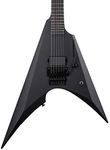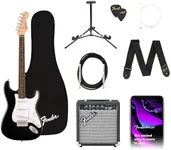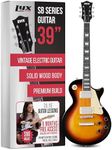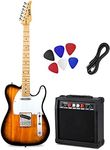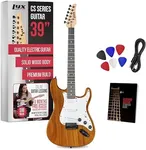Buying Guide for the Best Metal Electric Guitars
Choosing the right metal electric guitar can be a thrilling yet challenging experience. The key to finding the perfect guitar lies in understanding the various specifications and how they align with your playing style and preferences. By focusing on the right specs, you can ensure that your guitar delivers the sound, playability, and aesthetic that you desire for metal music.Body TypeThe body type of a guitar affects its sound and comfort. Solid body guitars are the most common for metal due to their sustain and resistance to feedback. They come in various shapes, from the classic Stratocaster style to more aggressive designs like the Flying V. Choose a body type that feels comfortable to play and matches your aesthetic preference.
PickupsPickups are crucial for shaping your guitar's sound. For metal, high-output humbuckers are preferred as they provide a thick, powerful tone with minimal noise. Active pickups, like those from EMG, offer even higher output and clarity, ideal for heavy distortion. If you play a lot of lead or solo work, consider pickups with a good balance of clarity and sustain.
Neck ProfileThe neck profile affects how the guitar feels in your hand. Thinner necks, often called 'slim' or 'fast' necks, are popular in metal for their ease of playability, especially for fast riffs and solos. Thicker necks can provide more comfort and support for some players. Try different neck profiles to see which one feels best for your playing style.
Scale LengthScale length is the distance between the nut and the bridge. Longer scale lengths (25.5 inches or more) are common in metal guitars as they provide tighter string tension, which is beneficial for lower tunings and heavier strings. Shorter scale lengths (24.75 inches) can offer a warmer tone and easier playability. Choose a scale length that complements your tuning preferences and playing comfort.
Bridge TypeThe bridge type can influence tuning stability and playability. Fixed bridges, like Tune-O-Matic or hardtail, offer stability and sustain, making them a solid choice for rhythm-heavy playing. Tremolo bridges, like Floyd Rose, allow for pitch bending and dive bombs, which are popular in metal solos. Consider your playing style and whether you need the flexibility of a tremolo or the stability of a fixed bridge.
Fretboard MaterialThe fretboard material can affect the feel and tone of the guitar. Common materials include rosewood, maple, and ebony. Rosewood offers a warm tone and smooth feel, maple provides a bright tone and slick surface, and ebony is known for its smoothness and fast playability. Choose a fretboard material that feels comfortable under your fingers and complements your desired tone.
Number of FretsThe number of frets determines the range of notes you can play. Metal guitars often have 24 frets, allowing for two full octaves per string, which is useful for high solos and complex riffs. Some guitars have 22 frets, which can be sufficient for many styles but may limit access to higher notes. Consider your playing style and whether you need the extended range of 24 frets.
Finish and AestheticsThe finish and aesthetics of a guitar are important for personal expression and stage presence. Metal guitars often feature bold, aggressive designs and finishes, such as matte black, metallic, or custom graphics. While aesthetics are subjective, choose a guitar that inspires you and matches your personal style, as this can enhance your overall playing experience.





